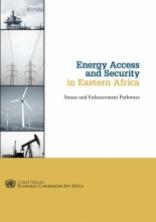Energy Access and Security in Eastern Africa

This report provides a sub-regional picture of energy access and security, reviews case studies from some selected member States to highlight lessons on energy access and security, looks at the environmental, transboundary energy resources, infrastructure and trade, technology and energy, and economic performance issues at length. Policymakers, decision makers and energy sector stakeholders may find it useful as they deliberate, advocate and implement programmes and strategies that will collectively enhance the state of energy access and security.
Electricity access rates range from 1 per cent in the new State of South Sudan (leaving 9.3 million people without access), 9 per cent in the Democratic Republic of Congo (DRC) (nearly 60 million without access) to 12 per cent in Uganda (more than 27 million people with- out access), 14 per cent in Tanzania (nearly 38 million without access), 18 per cent in Kenya (more than 32 million without access) and 22.5 per cent in Ethiopia (nearly 64.5 million without access). Africa, and particularly the Eastern Africa Sub-Region, therefore represents the most significant challenge to addressing the global energy access problem.
Though there are numerous challenges in the energy sector of Eastern Africa, there are also abundant opportunities. Member States are endowed with significant clean energy resources and development potentials in transboundary hydropower systems.